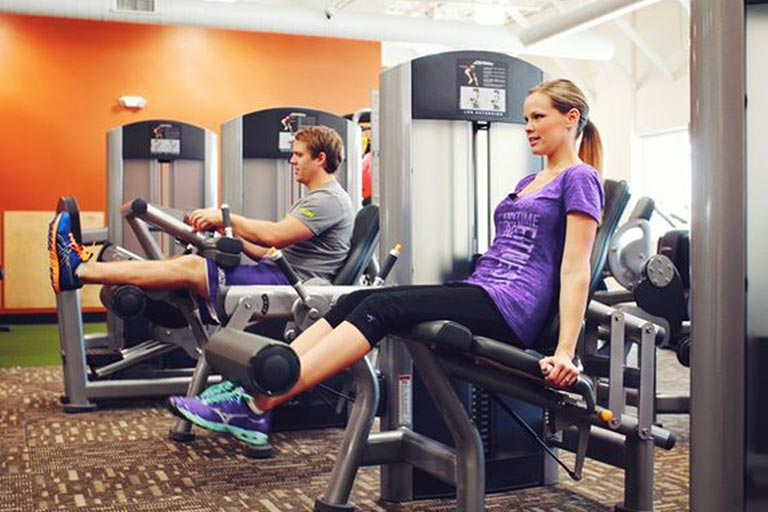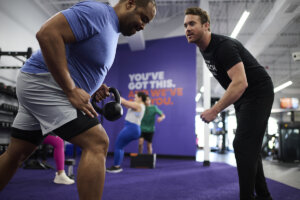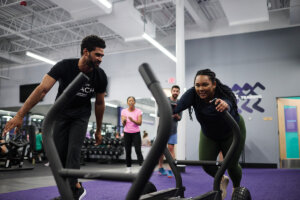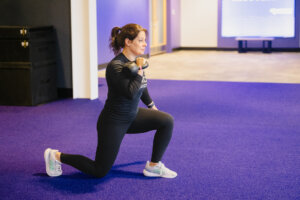“Thinspiration” content is taking the world by storm. Unfortunately, obsessing about the way we look and comparing ourselves to an unrealistic fitness or beauty trend is nothing new. But social media plays a large role in amplifying that message, bombarding our eyes with images of thigh gaps and other unrealistic, and often photoshopped, information and ideals.
A quick Google search for “thigh gap” will get you caught up on this phenomenon. Even influencers who claim “every body is beautiful” are seen revealing lots of skin, with not much of it attached to inner thigh fat. And hey, if you have a healthy body, rock it, but when a focus on thigh gaps overwhelms your feed, it doesn’t matter what information you’re sharing if your own photography idealizes the thigh gap. Which begs the question, how, in a world where so many worship the thigh gap, can we learn to tune out their Instagram feeds and love and accept our bodies?
This phenomenon doesn’t just apply to the thigh gap trend – there’s tons of content out there for both men and women that promotes unrealistic fitness goals: vilifying love handles, naming areas of the body as “bad” or “good,” telling us we have excess fat or trying to shame us into having a more “perfect body.” And while there’s nothing wrong with wanting to work out more, lead a healthier lifestyle, or fit into your jeans from college, any weight loss or fitness journey should come from the right place: a legitimate interest in getting healthier, rather than looking like what somebody online says is the ideal body goal.
First Things First – Defining Thigh Gap
Let’s start with some key information. A thigh gap is the space between a woman’s upper-mid thigh, right below where her hips join at her lady parts. The modeling, fitness, and cosmetic industry will all happily share information that the bigger the gap, the better, in an effort to separate the inner-thigh-fat haves from the inner-thigh-fat have-nots, causing the former group to be on an unending quest for the world’s best inner thigh exercises.
Negative thinspiration that idealizes slim legs and a thigh gap can make us want to hide our teenage girls from the world in response, throw away the TV and computer, and not allow one magazine to enter the house for fear that they start questioning their bodies. Exposure to that repeated messaging only breeds insecurity, eating disorders, body dysmorphia and worse. That’s why it’s so important to understand the facts about the thigh gap: what it is, what it’s not, and why you should never use it as a measure of health, attractiveness, or anything else.
It’s a Genetic Phenomenon
The thing is, inner thigh fat is normal, healthy, and most people have it. If they don’t, it’s less about their will or their worth and more about their DNA. On The Doctors, expert Dr. Travis Stork proved that inner thigh gaps are a genetic phenomenon based on bone structure. The primary determining factor for whether you have a thigh gap isn’t body weight, a healthy diet or strength training – it’s the width of your hips. Yup, that’s it! People with wider hip bones are more likely to have a natural thigh gap, and people with narrow-set hip bones are less likely to have one. When your hips are set closer together, your thighs and particularly your upper thighs are closer together. When you have wide hips, your thighs are farther apart.
It’s as simple as that – the thigh gap is genetic, based on your bone structure. Experts will tell you that if you have narrow-set hips, no amount of the so-called best exercises, reps on the inner thigh machine or dieting will magically give you a thigh gap. You’ll just end up exhausted, annoyed, deflated and probably grouchy that you still have inner thigh fat… inner thigh fat that’s entirely natural, and placed there based on genetics.
We know it’s science. But unfortunately, even though we have all the right information, we still put it on our list of fitness goals, request tips from trainers, prowl the web for the best exercises and thigh gap workouts, and seek out content that claims it can help us get rid of that excess fat. There are even treatments – one of them FDA approved – that can claim to help people reduce inner thigh fat. When really, it isn’t treatments we should be focusing on, but instead understanding that thigh gaps are genetic, building physical and mental strength, loving our bodies the way they were designed, and working out because we have a legitimate interest in getting healthier, not because we’re trying to meet an unrealistic goal.
Which makes us wonder, why not start shifting the narrative? And why not start to tell a story about health, no matter what shape that takes? Inner thigh fat, outer thigh fat, booty fat, belly fat and more. Because most people who work out, whether they’re doing strength training, yoga or running a marathon, have things they’d like to tone on that list, and that’s just life.
And while growing up usually helps us gain that perspective, some of us enter adulthood with seriously warped body image and a codependent, disordered relationship with food and exercise that’s left over from being young women and men exposed to messaging from what we see on our TVs, phones and advertisements. This can lead to obsessive exercising and an unhealthy diet designed to offer control over the uncontrollable (hello, thigh gap!).
Next Steps: The Message Must Change
Bottom line: our bodies don’t define us. Our self-worth should not be determined by any amount of inner thigh fat or any other body dysmorphic BS. Our thighs take us places: on long bike rides, up mountains, around corners, through Target, to the playground and back, up stairs, and through life. How about we thank our thighs and hope that every day they grow stronger to keep up with all we want to do?
Perhaps the best way to counter the thigh gap phenomenon is to replace the negative thinspiration images with those of incredibly strong, healthy women, thigh gap or not. (Because we don’t want to throw shade at women who were born with the DNA that excludes them from the inner-thigh-fat majority.) We celebrate all body types. And not designated areas of the upper body or lower body, but whole bodies that are not judged by their parts. Because you are more than your right leg, right? (And we’re sure your right leg is awesome, there’s just more to you.)
Strong, Healthy Thighs Start Here
Just to manage expectations, this workout content is NOT meant to blast inner thigh fat, or to provide recommendations for getting one. We don’t believe a thigh gap is something to seek out, or a good measurement of health. Instead, this workout is a series of some of the best exercises meant to strengthen the entirety of your upper legs so you can confidently stand in your power.
With that said, it’s time for some lower body love. As you perform this workout, push any thoughts of burning calories or toning up out of your mind. Instead, think about how powerful you feel and how grateful you are for everything your body does for you.
Stability Ball Wall Squats
This move strengthens your thigh muscles and glute muscles. Starting position: Place the ball against the wall and lean up against it at a 45 degree angle. Stand with your feet on the floor, shoulder-width apart, with your weight up against the ball. Bring your knees to 90 degrees as you inhale, and exhale, straightening your knees as you come up. Perform 15 reps.
The Split Squat
The split squat is a stationary lunge, and it’s a great move for building strength in your hip adductor muscles. Starting position: Stand with your feet on the floor, shoulder-width apart. Stand up straight with shoulders square and in a straight line with your hips as you prepare to bend your knees and step out on your right foot to lunge. Step forward with your right leg and place your right foot out in front of you, keeping your left leg back and your left foot on the ground resting on your left toes. Keep your arms at your side or put your hands on your hips. Lunge straight down, bending your right knee about 90 degrees and your left knee about 45 degrees, then straighten your right knee and repeat. After 15 reps, bring your right foot back, and do another set with your left foot forward, lunging with your left knee.
The Chair-Assisted Sissy Squat
For this squat you will need, surprisingly, a chair! Starting position: Stand tall with the chair beside you. Make sure both feet are shoulder width apart, knees soft. Place your left hand on your hip, your right leg alongside the chair and your right hand on the chair back. Come up to your toes, then carefully (and slowly) bend your knees while simultaneously leaning back to a 45 degree angle, then stand back up. Keep that core tight and make sure your knees, hips, chest and shoulders are in one straight line for the entire dip back. Do 15 reps, then switch sides placing your left foot on the floor next to the chair.
Now let’s move to the machines!
Leg Press
The first order of business with a leg press machine is the starting position. Adjust the back pad for comfort then start with a low weight. For beginners, 50 to 75 percent of your body weight is recommended. Warm up your leg muscles with about 12 reps and see how it feels. If your legs are not fatigued during the last few reps, increase the weight. Take care to slowly bend your legs back to protect your knees.
Leg Extension + Leg Curl Superset
Here we will work one set of muscles in your legs and then the opposite with no rest in-between. Use a lower weight here because you’ll be fatigued and have little time between sets. Starting position: For leg extensions, sit on the leg extension machine and point your toes upward as you squeeze your muscles and extend your legs to lift the bar up from the floor. After 12 reps, begin on the Leg curl machine. Let the pads rest just above your ankles, keep your hips tight against the bench and slowly bend your knees bringing your heels up until your legs are at about a 90 degree angle. Do 12 reps, rest for one minute, then repeat.
If your heels are coming up at different times on the leg curl machine, you may be using too much weight. Try to assess, for instance, if your left knee is bending more quickly than your right side, if it is, reduce the weight stack until things feel equal between your top leg and bottom leg.
If you’d like, you have the option to warm up with some additional cardio. When this workout is all said and done, look down at all your incredible lower body parts, your right leg, your left leg, those gorgeous, strong thighs, inner thigh fat and all, and say “Thank you, guys,” for getting through the workout and all the other services they do for you. Then, tell them they’re great without relentless inner thigh exercises and regardless of their gap status.



